English
Castellano
Català
The Rogerley Mine, Weardale - A Condensed History
Author: Jesse Fisher
Content by courtesy of : UK Mining Ventures
Reproduction of text and photos prohibited without permission of author.
Jesse Fisher, 380 Pennsylvania Ave., San Francisco, CA, 94107.
jesse@ukminingventures.com,e-mail
Copyright 2003 by the author
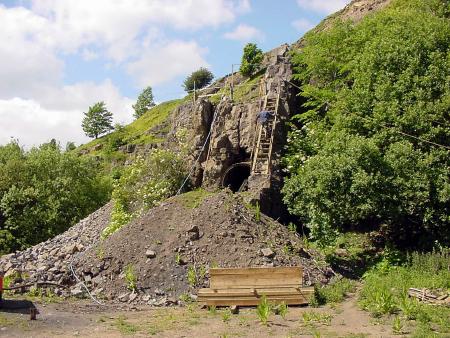
The Rogerley mine is located within an abandoned quarry of the same name, just east of the village of Stanhope, in Weardale. The quarry was originally operated during the mid-19th century as a source of limestone as flux for iron foundries in the nearby towns of Tow Law and Consett. There is no evidence that the quarry was ever worked for lead or fluorspar, and these ores were not likely to have been found in commercial quantities within the quarry. The ore veins, in fact, were considered impurities in the limestone, and when encountered they appear to have been discarded in a series of old tailings piles around the quarry.
Cumbria Mining and Mineral Company
The first work at what was to become the Rogerley mine was done in the early 1970s by the Cumbria Mining and Mineral Company. This company had recently been formed by mineral collecting partners Lindsay and Patricia Greenbank, and Michael and Brenda Sutcliffe with the intention of mining mineral specimens on a commercial basis. The concept of operating a mine solely for specimens was quite novel in the UK at the time, and was not taken seriously by many mineral agents. After unsuccessful attempts to obtain leases on properties in both Caldbeck Fells and Alston Moor, the partnership obtained permission to explore previously unworked fluorite-containing veins, which were exposed in the Rogerley Quarry.
Fluorite specimens were originally discovered along the base of the quarry wall by local mineral collectors. The source of the specimens was found to be a spot high up on the north face of the quarry, and Lindsay and Mike were soon investigating the occurrence by roping down from the top of the quarry. Leases for mineral rights were obtained from the land agents for the Church Commissioners of England, trespass rights were arranged with the local landowner, and the mine was operated on weekends for specimens over the course of the next 25 years.
The source of the fluorite specimens was found to be cavities in a N-S trending vein and associated flats exposed on the wall in the eastern section of the quarry. This vein is split into two stringers separated by about one meter where exposed on the quarry face, and has been named the Greenbank vein by Sir Kingsley Dunham. Work initially focused on cavities, which occur at the High Flats Horizon near the top of the Great Limestone, a competent rock unit that supports the wall of the quarry. During the early to mid 1970s a bench around 10 meters long was cut into the face approximately 20 meters above the floor of the quarry, and three fluorite-producing zones were encountered.
A second vein, named the Sutcliffe vein (Fisher and Greenbank, 2000) can be seen on the face of a western extension of the quarry, several hundred meters west of the Rogerley mine. This vein trends to the northeast and it is likely that it intersects the Greenbank vein somewhere to the north of the current mine workings. A limited amount of surface work was done on the Sutcliffe vein during 1976 and some good quality specimens of green and purple fluorite were found. Access to this outcrop was difficult to control, and highgraders were a constant problem, so work was soon shifted back to the original location.
During the late 1970s a cavity containing some exceptional bright green fluorite was discovered near the surface directly below the previously cut bench level. Over the next 18 months, working on weekends, a tunnel was driven northward for a distance of around 20 meters in search of more fluorite at this level. Unfortunately, the tunnel proved barren for the rest of its length and no work has been done there since.
The focus of mining shifted back to the upper level and during the 1980s a tunnel was driven northward into the quarry wall. Between 1982 - 1990 the partnership was also engaged in a zinc mining operation at Force Crag in Cumbria, so work at the Rogerley was limited to one or two weekends a month. During this time a series of cavities along the tunnel produced a high volume of material, resulting in a steady cash flow for the company. Most of the fluorite specimens found were large, opaque green crystals, some of which had smaller gemmy green crystals on the surface. To the east of this section of the tunnel the fluorite crystals tended to become smaller and more transparent and some excellent quality specimens were recovered. By the early 1990s the tunnel had been extended to a length of around 35 meters, but during the winter of 1992-93 the area around the portal collapsed, requiring the better part of the next year to reopen.
UK Mining Ventures
Not long after reopening the upper tunnel the Lindsay contracted a serious illness. While he has since recovered, he was forced to conclude that the rigors of hard rock mining were a thing of the past. He was in the process of closing the mine and selling off the equipment when the situation came to the attention of the current operators. After successfully completing agreements to secure mineral and trespass rights with the various parties involved and purchasing the necessary equipment, full time mining for specimens began in May of 1999.
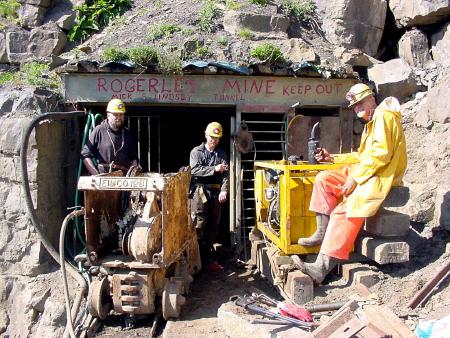
The mine had lain fallow for several years, and natural deterioration, along with occasional visits from highgraders had left it in need of considerable rehabilitation. This process involved mucking out and re-timbering portions of the tunnel, re-laying the track, re-building the stairs to the upper tunnel entrance, having equipment delivered to site and hoisted to the mine by crane, and installing a steel plate security door in the tunnel. By mid-June most of this had been accomplished and the crew could begin mining for specimens.
The mine tends to be wet year-round, and during clean-up one of the more beneficial tools proved to be pressurized water for washing the mud off of everything. While washing the tunnel walls, two areas of mineralization became apparent. At the north end of the tunnel was an area in which several pockets had been previously opened, but not completely extracted. One, named the Weasel Pocket after a former inhabitant (actually a stoat) who was forced to vacate on very short notice, contained large clusters of purple cubic fluorite crystals, which were coated with white finely crystalline quartz. The fluorite crystals were, unfortunately, opaque except around the edges, but made attractive specimens none the less.
The other area of mineralization occurred half way between the mine entrance and the end of the tunnel, in the area, which was successfully worked during the 1980s by the Cumbria Mining and Mineral Company. On the east side of the tunnel, green fluorite was exposed in numerous stringers and pocket remnants. Fluorite crystals on this side of the tunnel were smaller and clearer than those to the west, and it was obvious that this area had been productive in the past, as an alcove of about one meter had been driven eastward from the tunnel. On June 12 the miners pried loose a dangerous portion of the alcove roof and put in a set of timbers to stabilize the area. While washing the area during clean-up, a mud seam was noticed on the eastern face of the alcove. As the mud was washed away and a few slabs of rock were removed from the face, it became apparent that this was the opening of a fairly large cavity completely lined with crystals of green fluorite.
Over the course of the next few days, the pocket, now named the Black Sheep Pocket was opened up to approximately 1x1.5 meters. The floor was fairly broken up and numerous specimens ranging up to the size of small boulders were removed by hand. Some of the floor and most of the pocket ceiling was intact, however, allowing large plates of crystals, many with fluorite-coated, stalactite-like fingers of matrix to be removed using a diamond chain saw. The pocket proved to be an interconnected series of solution cavities, and extraction lasted through the summer. By the end of August the cavity had been opened up to approximately 1 meter high by 1.3 meters wide by 5 meters deep, and had yielded hundreds of specimens.
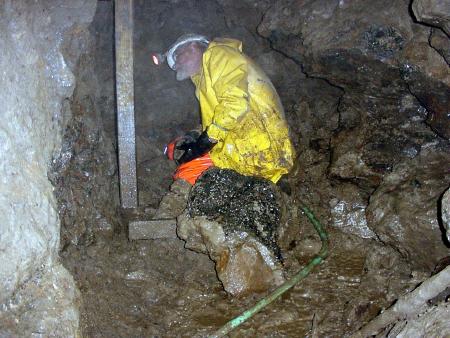
After this successful first season the partnership has reopened the mine each summer through the present. While the finds of the first summer had been largely a matter of dumb luck, the strategy for the second year was to access the mineralized flats by driving a new tunnel, branching to the northeast from the main adit near the mine entrance. This tunnel would, theoretically, intersect the flats near the rear of the first years productive zone, and provide better access to the mineralized area. Tunneling early in June and the mineralized area was reached in early July after driving approximately 15 meters of new tunnel. Collecting in this area continued through the summer, and in late August the miners broke into the far end of the previous summers pocket. Mineralization appears highly developed in this area, and fluorite-containing cavities were often encountered at three or more levels on the working face. During the coarse of the summer many well crystallized specimens were collected, some having glassy, lustrous penetration twins of green fluorite over 3 cm on edge.
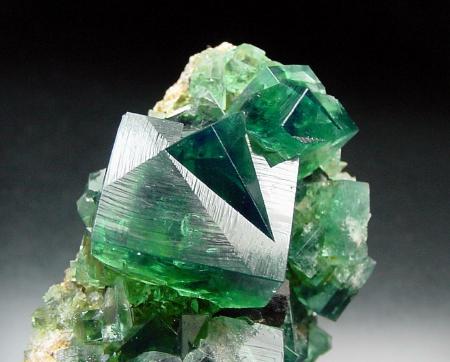
During the third summer (2001) work was left off in the Black Sheep pocket zone in favor of driving forward on both the east and main tunnels. After passing through a highly brecciated zone, the east tunnel entered an area now know as the Birthday Pocket, which produced some very nice, and often large plates covered with green fluorite crystals. On mid-summers day a cavity into the flats was discovered about 10 meters along the main tunnel from the original Black Sheep pocket opening. Specimens from this area - appropriately named the Solstice Pocket - though not numerous were very high quality, showing very little delustering or corrosion of the fluorite. Late in the season an exploratory tunnel heading west from the main tunnel opposite the Black Sheep pocket was started to see if flats existed to the west of the main vein as well as the east. After a couple of blasts green fluorite specimens were found here as well. This area is now know as the West Cross Cut and produced some excellent specimens at the end of the season.
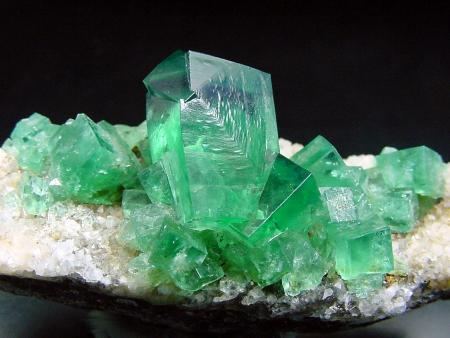
Collecting during the summer of 2002 concentrated in the areas of both the east tunnel and the West Cross Cut. Through the season the east tunnel was extended and by mid-August had reached the rear of the previous summers Solstice pocket, reconnecting with the main tunnel. Specimen production was continuous in this area but a small side pocket, known as The Dipper because the fluorite zone appears to be dipping into the floor produced some very fine and often large plates of fluorite. During the summer of 2003 collecting efforts again concentrated on the West Cross Cut, which has yielded what are perhaps some of the best specimens to date from the mine. Many fluorite specimens from this zone are highly lustrous and transparent and have a particularly intense deep green color. Unlike the Black Sheep zone to the east, the area around the West Cross Cut has undergone extensive replacement by iron carbonates, which have now oxidized creating a heavily iron-stained gossan-like matrix for the fluorite.
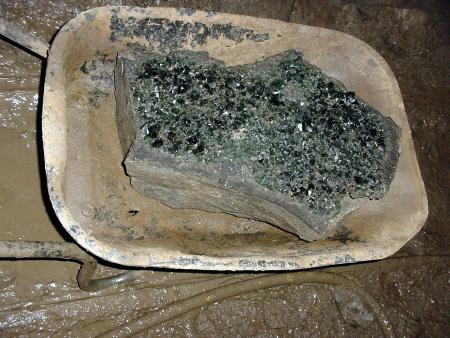
Mineralogy and Geology
Mineralized cavities are found in two distinct areas of the Rogerely Mine - in the vertical mineralized vein along which the original tunnel was driven, and in the metasomatic flats, which extend laterally from the vein. To date, UKMV has concentrated on the flats, which have been the source of numerous attractive specimens of emerald green fluorite. Fluorite crystals from the flats are often twinned on the octahedral {111} plane in a manner known as penetration twinning. Individual crystals occur up to around 8 cm in size, and sometimes have purple cores, or thin zones of pale yellow near the surface. Fluorite crystals smaller than around 3 cm are invariably twinned, while the larger ones are usually not. Small, crudely formed cubeoctahedral crystals of galena are commonly found associated with the fluorite. Larger fluorite crystals (up to 10 cm), both green and purple, have come from cavities in the vein, though these are usually opaque and untwinned.
Rogerley Mine fluorite (like much of that from other Weardale mines) is highly fluorescent, turning a bright bluish-white under long wave ultraviolet. The fluorite will also take on a purplish color in sunlight. This effect, known as daylight fluorescence appears unique to fluorite from the Weardale area. It has been speculated that this intense fluorescence is due to elevated rare-earth element (REE) content of the fluorite (Bill et al, 1967, Dunham, 1990), and recent analyses of Rogerley Mine fluorite (Falster et al, 2001) have confirmed elevated levels of a suite of REEs, including yttrium, cerium, lanthanum, samarium, and neodymium.
The Weardale mining district is located within the Northern Pennine Orefield, a 550 square mile (1400 sq. km) block of sedimentary rocks (limestones, sandstones, and shales) of Carboniferous age (around 325 million years old), into which ore-bearing veins were later intruded (Dunham, 1990). Mining in the region dates back to the 12th century, first for lead and iron, and more recently fluorspar. Famous specimen-producing mines in the district include the Heights, Boltsburn, Blackdene, Cambokeels, and Frazers Hush. Mineralization occurred through the emplacement of near vertical epigenetic hydrothermal ore-bearing veins along a set of regional fractures trending ENE and WNW. Horizontal metasomatic flats occur adjacent to many veins within some of the more competent units, and appear particularly well developed near vein intersections. The majority of the flats in Weardale occur in the Great Limestone, and it is cavities within the flats, which have produced many of the well-crystallized fluorite specimens Weardale is famous for. In the summer of 1999 the last operating commercial fluorspar mine in Weardale closed, ending a centuries long tradition of mining in the area. Future specimen production in Weardale - and perhaps the future of mining as well - is now in the hands of operations like the Rogerley.
Note: The Rogerley mine is on private property and closed to collecting by the general public. Visitors in small groups are generally welcome, but must make prior arrangements with the author. For more information concerning the Rogerley and other specimen-producing mines around Weardale, please see the UK Mining Ventures website at: www.ukminingventures.com
References
Bill, H., Sierro, J., and LaCroix, R., 1967, Origin of coloration in some fluorites. American Mineralogist, 52, 1003-1008.
Dunham, K. C., 1990, Geology of the Northern Pennine orefield, v. I, 2nd Ed. British Geological Survey, London, 299 p.
Falster, A.U., J.E. Fisher, and W.B. Simmons, 2001, REE content and fluorescence in fluorite from the Rogerley Mine, Weardale, County Durham, England (abs.), Rocks & Minerals, 76(4), 253.
Fisher, J., and Greenbank, L., 2000a, The Rogerley Mine, Weardale, County Durham, England, Rocks & Minerals, 75(1), 54-61.
Fisher, J.E., et L. Greenbank, 2000b, La Mine Rogerley, Weardale, comte de Durham, Angleterre. Le Regne Mineral, 34, 5-14. (in French)
Information | Mineral photos | VIDEOS | Articles | Fairs | Web directory | Classified ads | Minerals Books | Shop




